Page 63 of 720
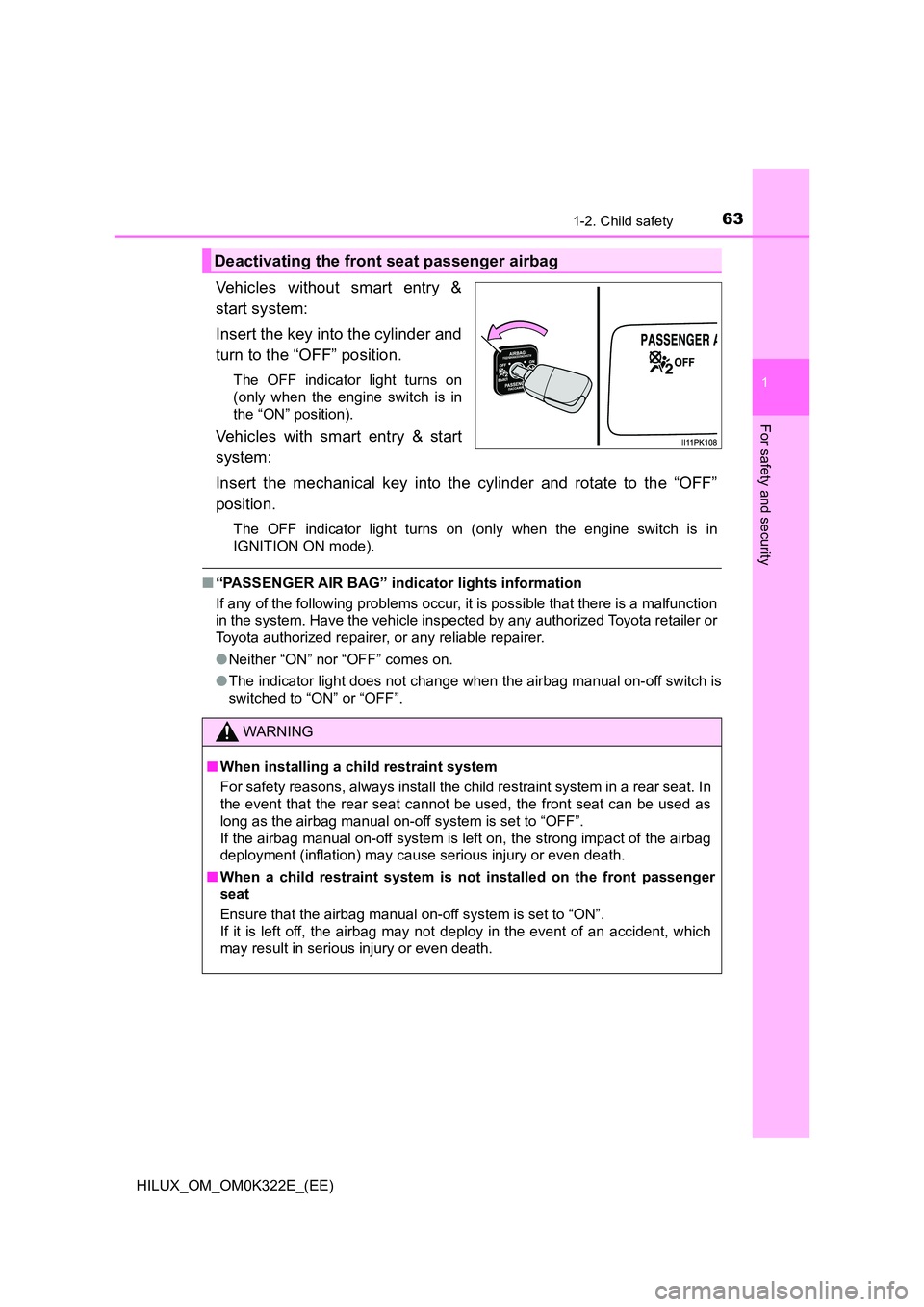
631-2. Child safety
1
HILUX_OM_OM0K322E_(EE)
For safety and security
Vehicles without smart entry &
start system:
Insert the key into the cylinder and
turn to the “OFF” position.
The OFF indicator light turns on
(only when the engine switch is in
the “ON” position).
Vehicles with smart entry & start
system:
Insert the mechanical key into the cylinder and rotate to the “OFF”
position.
The OFF indicator light turns on (only when the engine switch is in
IGNITION ON mode).
■ “PASSENGER AIR BAG” indicator lights information
If any of the following problems occur, it is possible that there is a malfunction
in the system. Have the vehicle inspected by any authorized Toyota retailer or
Toyota authorized repairer, or any reliable repairer.
● Neither “ON” nor “OFF” comes on.
● The indicator light does not change when the airbag manual on-off switch is
switched to “ON” or “OFF”.
Deactivating the front seat passenger airbag
WARNING
■ When installing a child restraint system
For safety reasons, always install the child restraint system in a rear seat. In
the event that the rear seat cannot be used, the front seat can be used as
long as the airbag manual on-off system is set to “OFF”.
If the airbag manual on-off system is left on, the strong impact of the airbag
deployment (inflation) may cause serious injury or even death.
■ When a child restraint system is not installed on the front passenger
seat
Ensure that the airbag manual on-off system is set to “ON”.
If it is left off, the airbag may not deploy in the event of an accident, which
may result in serious injury or even death.
Page 71 of 720
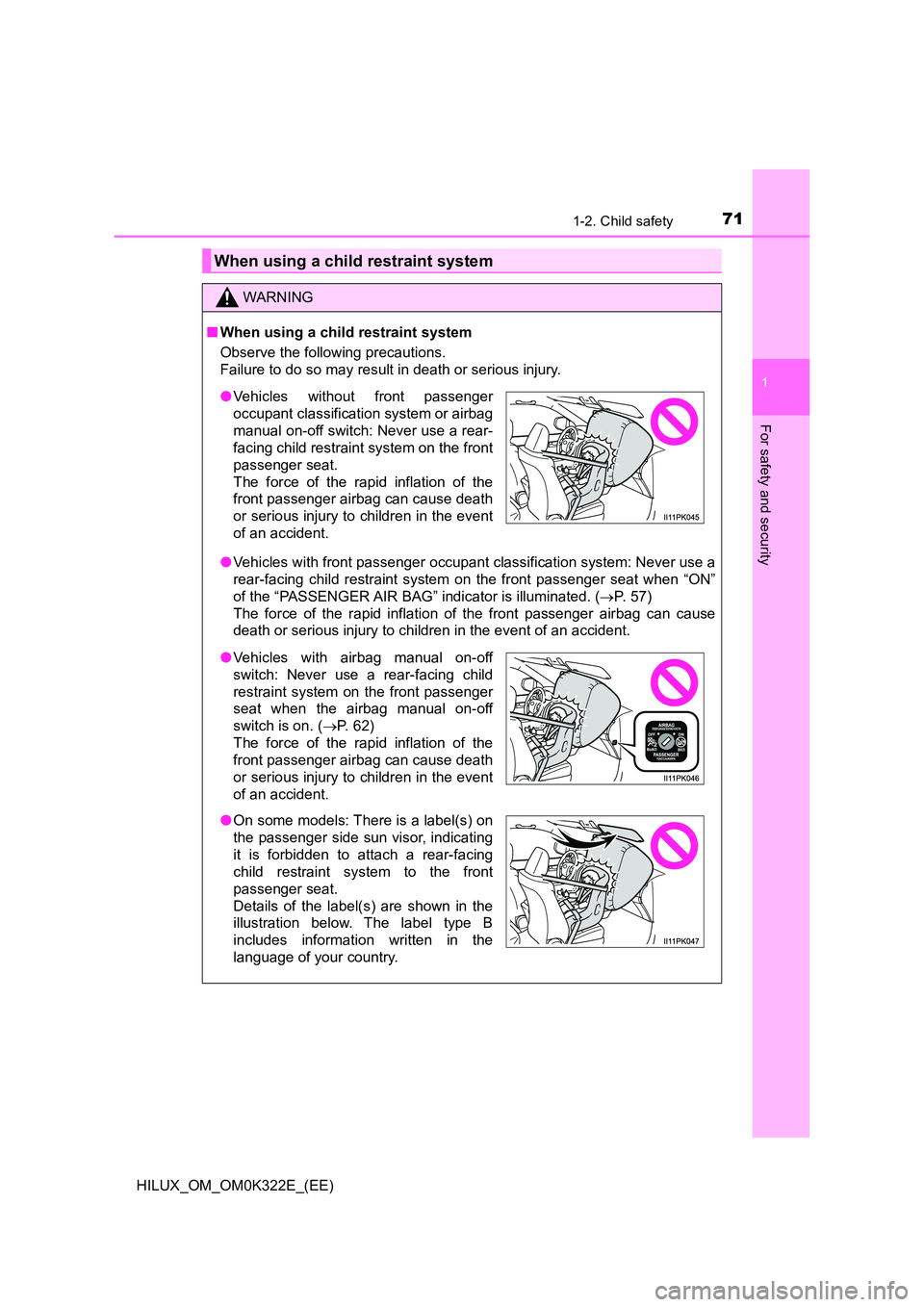
711-2. Child safety
1
HILUX_OM_OM0K322E_(EE)
For safety and security
When using a child restraint system
WARNING
■When using a child restraint system
Observe the following precautions.
Failure to do so may result in death or serious injury.
● Vehicles with front passenger occupant classification system: Never use a
rear-facing child restraint system on the front passenger seat when “ON”
of the “PASSENGER AIR BAG” indicator is illuminated. ( P. 57)
The force of the rapid inflation of the front passenger airbag can cause
death or serious injury to children in the event of an accident.
● Vehicles without front passenger
occupant classification system or airbag
manual on-off switch: Never use a rear-
facing child restraint system on the front
passenger seat.
The force of the rapid inflation of the
front passenger airbag can cause death
or serious injury to children in the event
of an accident.
● Vehicles with airbag manual on-off
switch: Never use a rear-facing child
restraint system on the front passenger
seat when the airbag manual on-off
switch is on. ( P. 62)
The force of the rapid inflation of the
front passenger airbag can cause death
or serious injury to children in the event
of an accident.
● On some models: There is a label(s) on
the passenger side sun visor, indicating
it is forbidden to attach a rear-facing
child restraint system to the front
passenger seat.
Details of the label(s) are shown in the
illustration below. The label type B
includes information written in the
language of your country.
Page 73 of 720
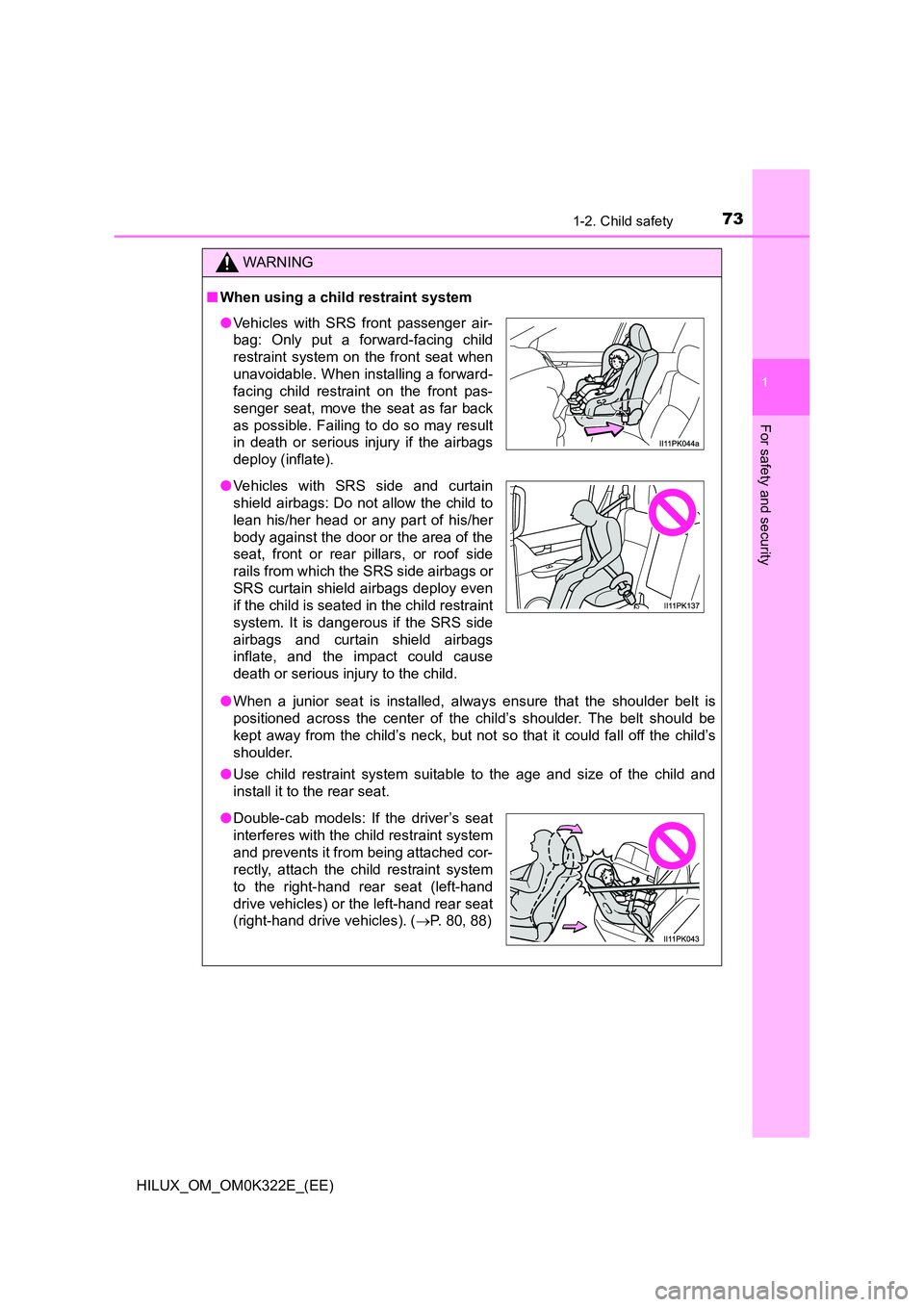
731-2. Child safety
1
HILUX_OM_OM0K322E_(EE)
For safety and security
WARNING
■When using a child restraint system
● When a junior seat is installed, always ensure that the shoulder belt is
positioned across the center of the child’s shoulder. The belt should be
kept away from the child’s neck, but not so that it could fall off the child’s
shoulder.
● Use child restraint system suitable to the age and size of the child and
install it to the rear seat.
● Vehicles with SRS front passenger air-
bag: Only put a forward-facing child
restraint system on the front seat when
unavoidable. When installing a forward-
facing child restraint on the front pas-
senger seat, move the seat as far back
as possible. Failing to do so may result
in death or serious injury if the airbags
deploy (inflate).
● Vehicles with SRS side and curtain
shield airbags: Do not allow the child to
lean his/her head or any part of his/her
body against the door or the area of the
seat, front or rear pi llars, or roof side
rails from which the SRS side airbags or
SRS curtain shield airbags deploy even
if the child is seated in the child restraint
system. It is dangerous if the SRS side
airbags and curtain shield airbags
inflate, and the impact could cause
death or serious injury to the child.
● Double-cab models: If the driver’s seat
interferes with the child restraint system
and prevents it from being attached cor-
rectly, attach the child restraint system
to the right-hand rear seat (left-hand
drive vehicles) or the left-hand rear seat
(right-hand drive vehicles). ( P. 8 0 , 8 8 )
Page 75 of 720
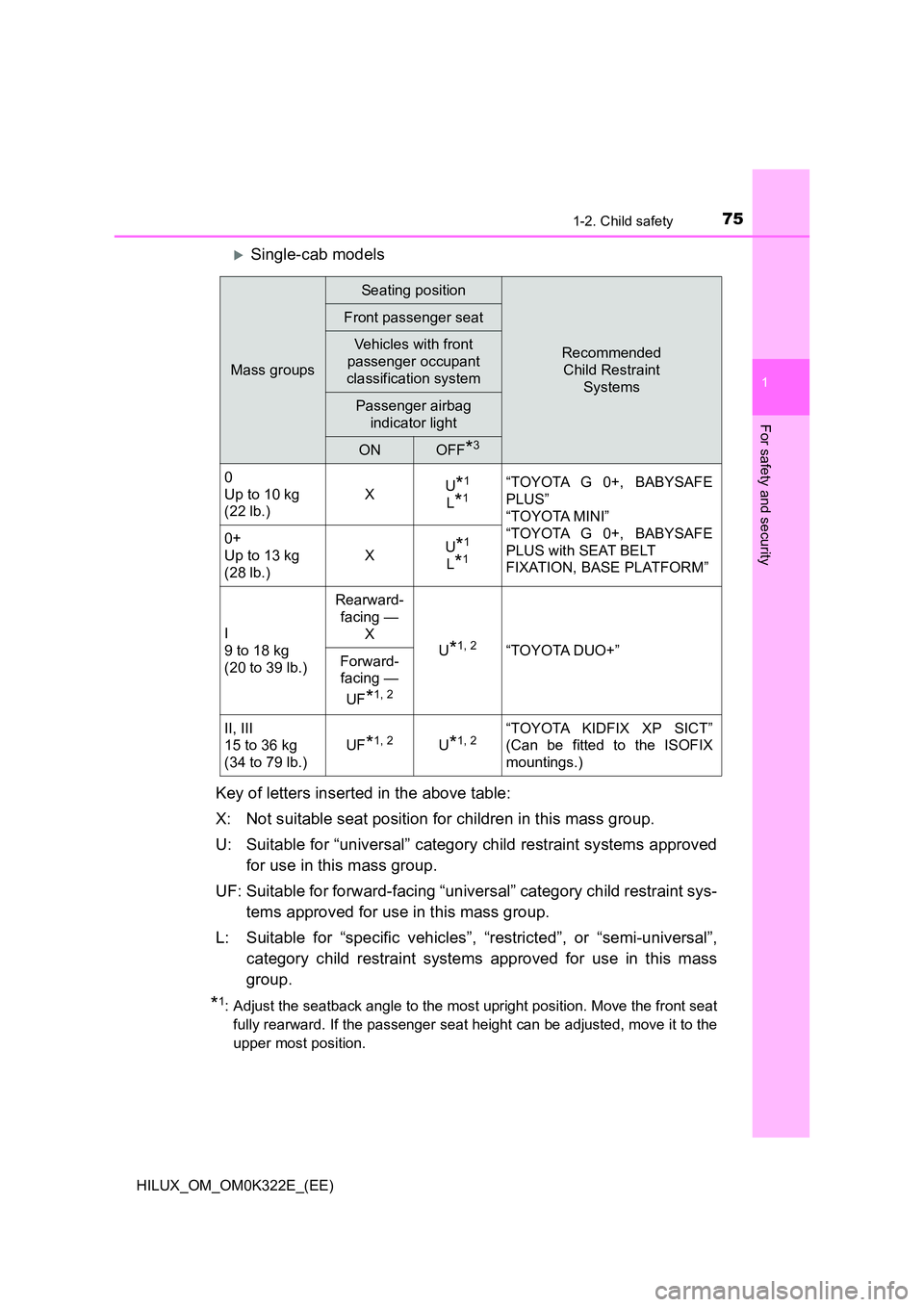
751-2. Child safety
1
HILUX_OM_OM0K322E_(EE)
For safety and security
Single-cab models
Key of letters inserted in the above table:
X: Not suitable seat position for children in this mass group.
U: Suitable for “universal” category child restraint systems approved
for use in this mass group.
UF: Suitable for forward-facing “universal” category child restraint sys-
tems approved for use in this mass group.
L: Suitable for “specific vehicles”, “restricted”, or “semi-universal”,
category child restraint systems approved for use in this mass
group.
*1: Adjust the seatback angle to the most upright position. Move the front seat
fully rearward. If the passenger seat height can be adjusted, move it to the
upper most position.
Mass groups
Seating position
Recommended
Child Restraint
Systems
Front passenger seat
Vehicles with front
passenger occupant
classification system
Passenger airbag
indicator light
ONOFF*3
0
Up to 10 kg
(22 lb.)
X U*1
L*1“TOYOTA G 0+, BABYSAFE
PLUS”
“TOYOTA MINI”
“TOYOTA G 0+, BABYSAFE
PLUS with SEAT BELT
FIXATION, BASE PLATFORM”
0+
Up to 13 kg
(28 lb.)
X U*1
L*1
I
9 to 18 kg
(20 to 39 lb.)
Rearward-
facing —
X
U*1, 2“TOYOTA DUO+” Forward-
facing —
UF*1, 2
II, III
15 to 36 kg
(34 to 79 lb.)
UF*1, 2U*1, 2“TOYOTA KIDFIX XP SICT”
(Can be fitted to the ISOFIX
mountings.)
Page 76 of 720
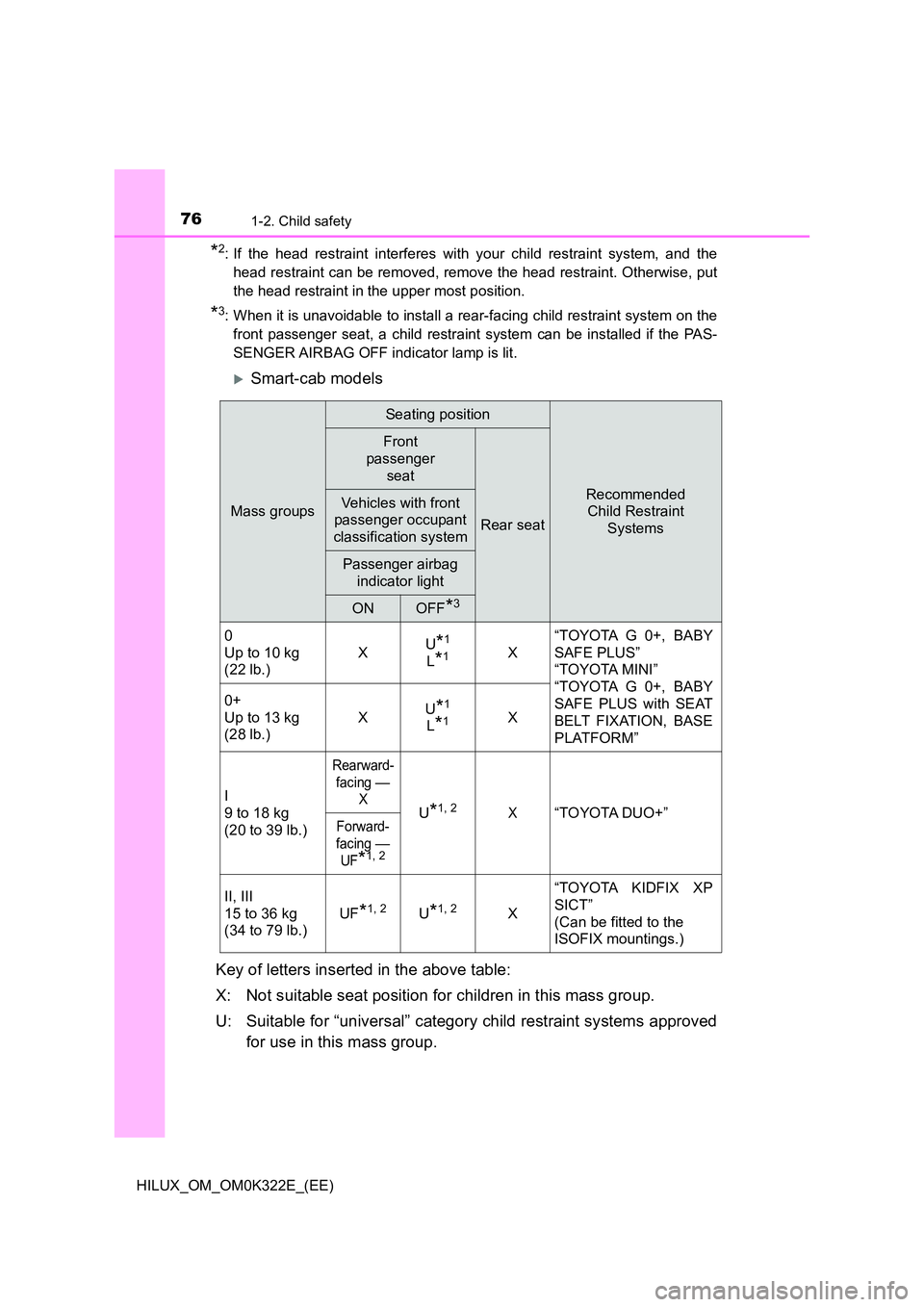
761-2. Child safety
HILUX_OM_OM0K322E_(EE)
*2: If the head restraint interferes with your child restraint system, and the
head restraint can be removed, remove the head restraint. Otherwise, put
the head restraint in the upper most position.
*3: When it is unavoidable to install a rear-facing child restraint system on the
front passenger seat, a child restraint system can be installed if the PAS-
SENGER AIRBAG OFF indicator lamp is lit.
Smart-cab models
Key of letters inserted in the above table:
X: Not suitable seat position for children in this mass group.
U: Suitable for “universal” category child restraint systems approved
for use in this mass group.
Mass groups
Seating position
Recommended
Child Restraint
Systems
Front
passenger
seat
Rear seat
Vehicles with front
passenger occupant
classification system
Passenger airbag
indicator light
ONOFF*3
0
Up to 10 kg
(22 lb.)
X U*1
L*1X
“TOYOTA G 0+, BABY
SAFE PLUS”
“TOYOTA MINI”
“TOYOTA G 0+, BABY
SAFE PLUS with SEAT
BELT FIXATION, BASE
PLATFORM”
0+
Up to 13 kg
(28 lb.)
X U*1
L*1X
I
9 to 18 kg
(20 to 39 lb.)
Rearward-
facing —
XU*1, 2X“TOYOTA DUO+”Forward-
facing —
UF*1, 2
II, III
15 to 36 kg
(34 to 79 lb.)
UF*1, 2U*1, 2X
“TOYOTA KIDFIX XP
SICT”
(Can be fitted to the
ISOFIX mountings.)
Page 77 of 720
771-2. Child safety
1
HILUX_OM_OM0K322E_(EE)
For safety and security
UF: Suitable for forward-facing “universal” category child restraint sys-
tems approved for use in this mass group.
L: Suitable for “specific vehicles”, “restricted”, or “semi-universal”,
category child restraint systems approved for use in this mass
group.
*1: Adjust the seatback angle to the most upright position. Move the front seat
fully rearward. If the passenger seat height can be adjusted, move it to the
upper most position.
*2: If the head restraint interferes with your child restraint system, and the
head restraint can be removed, remove the head restraint. Otherwise, put
the head restraint in the upper most position.
*3: When it is unavoidable to install a rear-facing child restraint system on the
front passenger seat, a child restraint system can be installed if the PAS-
SENGER AIRBAG OFF indicator lamp is lit.
Page 78 of 720
781-2. Child safety
HILUX_OM_OM0K322E_(EE)
Double-cab models
Mass
groups
Seating position
Recommended
Child
Restraint
Systems
Front passenger seatRear seat
Vehicles with
airbag manual
on-off switch
Vehicles with
front passenger
occupant
classification
systemOut-
boardCenter
Airbag manual
on-off switch
Passenger
airbag
indicator light
ONOFFONOFF*3
0
U p t o 1 0 k g
(22 lb.)
X U*1
L*1XU*1
L*1U
L X
“TOYOTA G
0+, BABY
SAFE PLUS”
“TOYOTA
MINI”
“TOYOTA G
0+, BABY
SAFE PLUS
with SEAT
BELT
FIXATION,
BASE
PLATFORM”
0+
U p t o 1 3 k g
(28 lb.)
X U*1
L*1XU*1
L*1U
L X
I
9 to 18 kg
(20 to 39
lb.)
Rearward-
facing —
X U*1, 2
Rearward-
facing —
X U*1, 2U*2X“TOYOTA
DUO+”Forward-
facing —
UF*1, 2
Forward-
facing —
UF*1, 2
II, III
15 to 36 kg
(34 to 79
lb.)
UF*1, 2U*1, 2UF*1, 2U*1, 2U*2X
“TOYOTA
KIDFIX XP
SICT”
(Can be fit-
ted to the
ISOFIX
mountings.)
Page 79 of 720
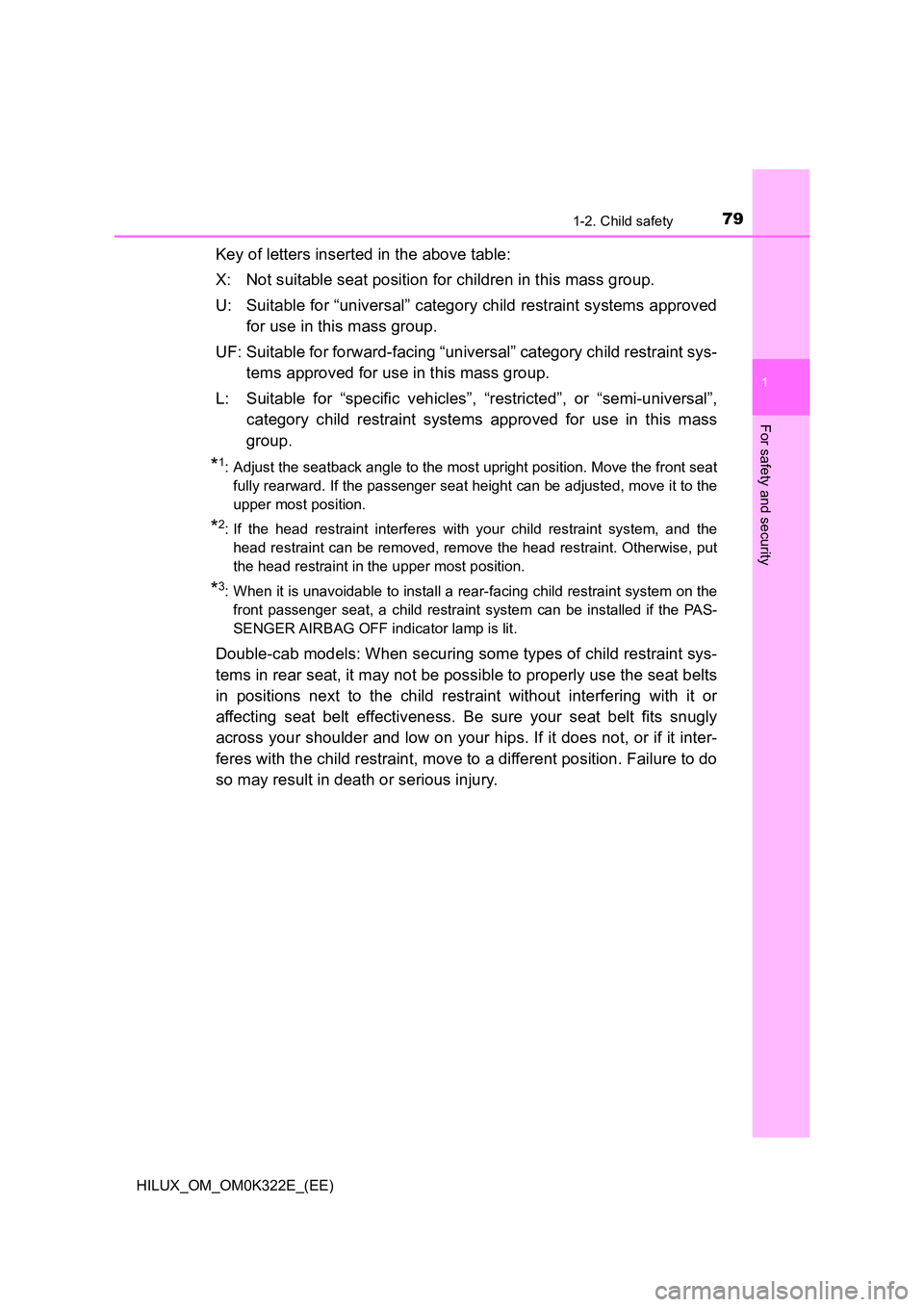
791-2. Child safety
1
HILUX_OM_OM0K322E_(EE)
For safety and security
Key of letters inserted in the above table:
X: Not suitable seat position for children in this mass group.
U: Suitable for “universal” category child restraint systems approved
for use in this mass group.
UF: Suitable for forward-facing “universal” category child restraint sys-
tems approved for use in this mass group.
L: Suitable for “specific vehicles”, “restricted”, or “semi-universal”,
category child restraint systems approved for use in this mass
group.
*1: Adjust the seatback angle to the most upright position. Move the front seat
fully rearward. If the passenger seat height can be adjusted, move it to the
upper most position.
*2: If the head restraint interferes with your child restraint system, and the
head restraint can be removed, remove the head restraint. Otherwise, put
the head restraint in the upper most position.
*3: When it is unavoidable to install a rear-facing child restraint system on the
front passenger seat, a child restraint system can be installed if the PAS-
SENGER AIRBAG OFF indicator lamp is lit.
Double-cab models: When securing some types of child restraint sys-
tems in rear seat, it may not be possible to properly use the seat belts
in positions next to the child restraint without interfering with it or
affecting seat belt effectiveness. Be sure your seat belt fits snugly
across your shoulder and low on your hips. If it does not, or if it inter-
feres with the child restraint, move to a different position. Failure to do
so may result in death or serious injury.